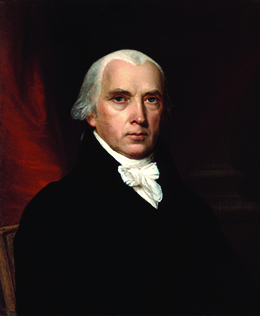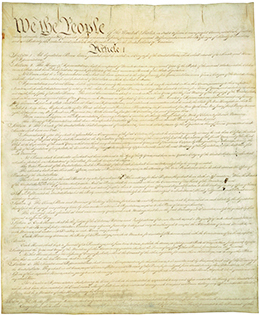| << Chapter < Page | Chapter >> Page > |
The draft constitution was finished in September 1787. The delegates decided that in order for the new national government to be implemented, each state must first hold a special ratifying convention. When nine of the thirteen had approved the plan, the constitution would go into effect.
When the American public learned of the new constitution, opinions were deeply divided, but most people were opposed. To salvage their work in Philadelphia, the architects of the new national government began a campaign to sway public opinion in favor of their blueprint for a strong central government. In the fierce debate that erupted, the two sides articulated contrasting visions of the American republic and of democracy. Supporters of the 1787 Constitution, known as Federalists , made the case that a centralized republic provided the best solution for the future. Those who opposed it, known as Anti-Federalists , argued that the Constitution would consolidate all power in a national government, robbing the states of the power to make their own decisions. To them, the Constitution appeared to mimic the old corrupt and centralized British regime, under which a far-off government made the laws. Anti-Federalists argued that wealthy aristocrats would run the new national government, and that the elite would not represent ordinary citizens; the rich would monopolize power and use the new government to formulate policies that benefited their class—a development that would also undermine local state elites. They also argued that the Constitution did not contain a bill of rights.
New York’s ratifying convention illustrates the divide between the Federalists and Anti-Federalists. When one Anti-Federalist delegate named Melancton Smith took issue with the scheme of representation as being too limited and not reflective of the people, Alexander Hamilton responded:
It has been observed by an honorable gentleman [Smith], that a pure democracy, if it were practicable, would be the most perfect government. Experience has proven, that no position in politics is more false than this. The ancient democracies, in which the people themselves deliberated, never possessed one feature of good government. Their very character was tyranny; their figure deformity: When they assembled, the field of debate presented an ungovernable mob, not only incapable of deliberation, but prepared for every enormity. In these assemblies, the enemies of the people brought forward their plans of ambition systematically. They were opposed by their enemies of another party; and it became a matter of contingency, whether the people subjected themselves to be led blindly by one tyrant or by another.
The Federalists, particularly John Jay, Alexander Hamilton, and James Madison, put their case to the public in a famous series of essays known as The Federalist Papers . These were first published in New York and subsequently republished elsewhere in the United States.
The tenth essay in The Federalist Papers , often called Federalist No. 10, is one of the most famous. Written by James Madison ( [link] ), it addresses the problems of political parties (“factions”). Madison argued that there were two approaches to solving the problem of political parties: a republican government and a democracy. He argued that a large republic provided the best defense against what he viewed as the tumult of direct democracy. Compromises would be reached in a large republic and citizens would be represented by representatives of their own choosing.

From this view of the subject, it may be concluded, that a pure Democracy, by which I mean a Society consisting of a small number of citizens, who assemble and administer the Government in person, can admit of no cure for the mischiefs of faction. A common passion or interest will, in almost every case, be felt by a majority of the whole; a communication and concert result from the form of Government itself; and there is nothing to check the inducements to sacrifice the weaker party, or an obnoxious individual. Hence it is, that such Democracies have ever been spectacles of turbulence and contention; have ever been found incompatible with personal security, or the rights of property; and have in general been as short in their lives, as they have been violent in their deaths. Theoretic politicians, who have patronized this species of Government, have erroneously supposed, that by reducing mankind to a perfect equality in their political rights, they would, at the same time, be perfectly equalized and assimilated in their possessions, their opinions, and their passions.
A Republic, by which I mean a Government in which the scheme of representation takes place, opens a different prospect, and promises the cure for which we are seeking. Let us examine the points in which it varies from pure Democracy, and we shall comprehend both the nature of the cure, and the efficacy which it must derive from the Union.
The two great points of difference, between a Democracy and a Republic, are, first, the delegation of the Government, in the latter, to a small number of citizens elected by the rest: Secondly, the greater number of citizens, and greater sphere of country, over which the latter may be extended.
Does Madison recommend republicanism or democracy as the best form of government? What arguments does he use to prove his point?
Read the full text of Federalist No. 10 on Wikisource. What do you think are Madison’s most and least compelling arguments? How would different members of the new United States view his arguments?
Including all the state ratifying conventions around the country, a total of fewer than two thousand men voted on whether to adopt the new plan of government. In the end, the Constitution only narrowly won approval ( [link] ). In New York, the vote was thirty in favor to twenty-seven opposed. In Massachusetts, the vote to approve was 187 to 168, and some claim supporters of the Constitution resorted to bribes in order to ensure approval. Virginia ratified by a vote of eighty-nine to seventy-nine, and Rhode Island by thirty-four to thirty-two. The opposition to the Constitution reflected the fears that a new national government, much like the British monarchy, created too much centralized power and, as a result, deprived citizens in the various states of the ability to make their own decisions.

The economic crisis of the 1780s, shortcomings of the Articles of Confederation, and outbreak of Shays’ Rebellion spurred delegates from twelve of the thirteen states to gather for the Constitutional Convention of 1787. Although the stated purpose of the convention was to modify the Articles of Confederation, their mission shifted to the building of a new, strong federal government. Federalists like James Madison and Alexander Hamilton led the charge for a new United States Constitution, the document that endures as the oldest written constitution in the world, a testament to the work done in 1787 by the delegates in Philadelphia.

Notification Switch
Would you like to follow the 'U.s. history' conversation and receive update notifications?